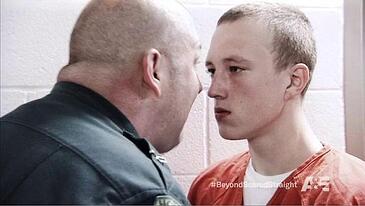Treating Employees Like A Problem-Child In Safety
Before you plan your next safety meeting, ask yourself if your intent is to scare your workers into compliance.

Do you want them to be afraid, or to get them to voluntarily buy-in to safety as a personal value?
Scared-Straight programs use face-to-face prison visits to scare teenagers into changing their ways. Former gang members, drug addicts, drug dealers, bullies and convicts visit schools to preach a "don't do what I did" message. All of these efforts can influence and save lives at a time in a child's life when fitting-in is important. So why not include safety?
It is easier to scare a child
It is easier to scare a child into choosing safety than to reprogram an adult. Consequently, you would never bring a former gang member, drug addict or prisoner into the workplace to scare your entire staff into conformity.
Long-term safety buy-in doesn't come from hearing about a devastating workplace injury - you are working with adults, not children. Adults know the risk of injury already, and trying to frighten them into compliance won't work inthe long term.
Injury speakers (workplace accident survivors) would do well in schools. Their don't-do-what-I-did message lines up well with anti-smoking, anti-gang, anti-drug, anti-prison and anti-bullying messages. If you want to create a safety attitude, instil in a child's young mind that the workplace can be dangerous - where accidents are waiting to happen.
Not everyone who goes to work gets injured
The challenge with trying to scare adults into safety is that compared to the numbers who work accident-free, on-the-job injury numbers are minuscule. So one might ask, why does safety, as an industry, concentrate on the risks of injury instead of building on the positives of large numbers of incident-free workdays?
Perhaps the most important of all questions should be: why does safety tend to embrace accident victims as messengers of safety? Would not a safety expert be one who has worked accident-free? Accident victims turned speaker, by virtue of their injury, are not safety experts - they are injury experts. Surviving a workplace accident does not qualify you as an expert on safety any more than surviving a car crash qualifies you as a driving instructor.
Negative reinforcement does not automatically create a positive outcome. Injury-survivors turned safety-evangelists should be commended for wanting to turn their negative into a positive. But the relationship is rarely a straight line. Their misplaced energy would have a more far-reaching effect if they would move their efforts to a younger age demographic.
Fat people don't speak at fitness conferences
The morbidly obese don't get hired to speak at meetings of fitness trainers or nutritionists. Bankruptcy victims don't get hired for their don't-do-what-I-did advice at meetings of financial planners or stock brokers. Attendees don't want to pay money to hear stories of failure. They want to hear success stories from top performers.
Unfortunately, negative is easier to sell. It has greater shock-and-awe. But does it have lasting value or change a workplace safety culture? No, not really. But safety managers do it because it's expedient, it is graphic, it is shocking, and it gets attention. And, sadly, they do it because they don't know what else to do.
Success in safety shouldn't be wrapped in a gut-wrenching story. Safety needs to grow up and look to the leaders, the success stories to bolster their cause like every other industry. If you want your people to buy-in to safety, then give them successful examples to take their cues from.
Your employees are not "problem children"
Treating good workers the same way you would treat a problem-child is the wrong approach. To scare someone safe, you've got to do it before they join the gang, before they start taking or selling drugs, before they start gambling, before they get into trouble with the law and before they start working unsafely. It should come when the collective peer-influence is highest - in high school.
Get to young workers early
Companies should be taking the initiative to sponsor injury speakers to sell safety to high-school students. You scare them straight just as they're getting into the workforce part-time, not after they've been in the industry for thirty years. You should be exposing kids to messages of the hazards of being unsafe when they fancy themselves invincible and already "know" everything.
Meanwhile, remove the negative reinforcement from your own workplace safety program. Stop trying to scare your people into conformity. It isn't working. Instead, focus on building a safety program on positives. Appeal to your workers sense of family, strengths and their personal values - not their fears. And if you find yourself at a loss where to start, I'd be pleased to have that conversation with you and show you one way to start building on positives.


